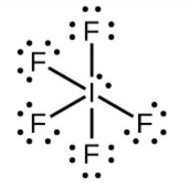
$\text{PC}{{\text{l}}_{5}}$ has a shape of trigonal bipyramidal whereas $\text{I}{{\text{F}}_{5}}$ has the shape of a square pyramid. It is due to
A. presence of an unshared electron pair on I which is oriented so as to minimise the repulsion while in P in $\text{PC}{{\text{l}}_{5}}$ has no unshared pair.
B. octet of P is complete while that of I is incomplete.
C. P and I are of different groups.
D. F and Cl have different degrees of repulsion.
Answer
522.5k+ views
Hint: Phosphorus has five electrons in the outermost shell and it can make five bonds with other molecules whereas iodine has 7 electrons and has a tendency to accept a pair of electrons so it forms mainly a single bond.
Complete answer:
-In $\text{PC}{{\text{l}}_{5}}$, the electronic configuration of phosphorus is $\text{1}{{\text{s}}^{2}}\text{ 2}{{\text{s}}^{2}}\text{ 2}{{\text{p}}^{6}}\text{ 3}{{\text{s}}^{2}}\text{ 3}{{\text{p}}^{3}}$ to form five bonds with chlorine electron form s-orbital is excited to the vacant d-orbital due to which phosphorus gains the ability to make 5 bonds.
-Now, it has a total of five unpaired electrons.
-So, the hybridisation of phosphorus is $\text{s}{{\text{p}}^{3}}\text{d}$ and the geometry will be trigonal bipyramidal.
-Because it has 5 bond pairs and 0 lone pairs.

-In $\text{I}{{\text{F}}_{5}}$, according to the electronic configuration of iodine two electrons from 5p-orbital are excited to move to the 5d-orbital.
-So, now iodine tends to make 5 bonds and along with it have one lone pair.
-The lone pair will cause the repulsion towards the bond pair and increases the bond angles that’s why it is oriented in such a way that it causes less repulsion.
-So, the hybridisation will be $\text{s}{{\text{p}}^{3}}{{\text{d}}^{2}}$and the geometry will be square pyramidal.
-The structure is:

So, the correct answer is “Option A”.
Note: The lone pair- lone pair repulsion causes maximum repulsion than lone pair-bond pair and lone pair-bond pair repulsion is more than the bond pair-bond pair repulsion.
Complete answer:
-In $\text{PC}{{\text{l}}_{5}}$, the electronic configuration of phosphorus is $\text{1}{{\text{s}}^{2}}\text{ 2}{{\text{s}}^{2}}\text{ 2}{{\text{p}}^{6}}\text{ 3}{{\text{s}}^{2}}\text{ 3}{{\text{p}}^{3}}$ to form five bonds with chlorine electron form s-orbital is excited to the vacant d-orbital due to which phosphorus gains the ability to make 5 bonds.
-Now, it has a total of five unpaired electrons.
-So, the hybridisation of phosphorus is $\text{s}{{\text{p}}^{3}}\text{d}$ and the geometry will be trigonal bipyramidal.
-Because it has 5 bond pairs and 0 lone pairs.

-In $\text{I}{{\text{F}}_{5}}$, according to the electronic configuration of iodine two electrons from 5p-orbital are excited to move to the 5d-orbital.
-So, now iodine tends to make 5 bonds and along with it have one lone pair.
-The lone pair will cause the repulsion towards the bond pair and increases the bond angles that’s why it is oriented in such a way that it causes less repulsion.
-So, the hybridisation will be $\text{s}{{\text{p}}^{3}}{{\text{d}}^{2}}$and the geometry will be square pyramidal.
-The structure is:

So, the correct answer is “Option A”.
Note: The lone pair- lone pair repulsion causes maximum repulsion than lone pair-bond pair and lone pair-bond pair repulsion is more than the bond pair-bond pair repulsion.
Recently Updated Pages
The number of solutions in x in 02pi for which sqrt class 12 maths CBSE

Write any two methods of preparation of phenol Give class 12 chemistry CBSE

Differentiate between action potential and resting class 12 biology CBSE

Two plane mirrors arranged at right angles to each class 12 physics CBSE

Which of the following molecules is are chiral A I class 12 chemistry CBSE

Name different types of neurons and give one function class 12 biology CBSE

Trending doubts
One Metric ton is equal to kg A 10000 B 1000 C 100 class 11 physics CBSE

Explain zero factorial class 11 maths CBSE

What is 1s 2s 2p 3s 3p class 11 chemistry CBSE

Discuss the various forms of bacteria class 11 biology CBSE

State the laws of reflection of light

Difference Between Prokaryotic Cells and Eukaryotic Cells




